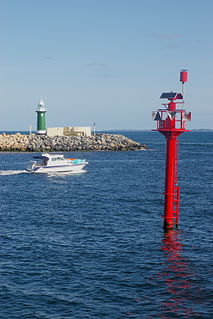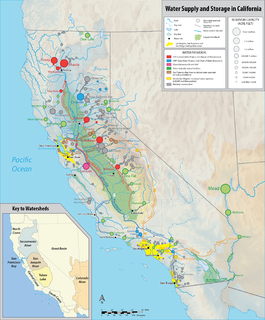Related Research Articles
In United States constitutional law, a regulatory taking is a situation in which a government regulation limits the uses of private property to such a degree that the regulation effectively deprives the property owners of economically reasonable use or value of their property to such an extent that it deprives them of utility or value of that property, even though the regulation does not formally divest them of title to it.

The freedom to roam, or "everyman's right", is the general public's right to access certain public or privately owned land, lakes, and rivers for recreation and exercise. The right is sometimes called the right of public access to the wilderness or the "right to roam".
Riparian water rights is a system for allocating water among those who possess land along its path. It has its origins in English common law. Riparian water rights exist in many jurisdictions with a common law heritage, such as Canada, Australia, and states in the eastern United States.
Prior appropriation water rights is the legal doctrine that the first person to take a quantity of water from a water source for "beneficial use" has the right to continue to use that quantity of water for that purpose.
Water right in water law refers to the right of a user to use water from a water source, e.g., a river, stream, pond or source of groundwater. In areas with plentiful water and few users, such systems are generally not complicated or contentious. In other areas, especially arid areas where irrigation is practiced, such systems are often the source of conflict, both legal and physical. Some systems treat surface water and ground water in the same manner, while others use different principles for each.

A body of water, such as a river, canal or lake, is navigable if it is deep, wide and calm enough for a water vessel to pass safely. Such a navigable water is called a waterway, and is preferably with few obstructions against direct traverse that needed avoiding, such as rocks, reefs or trees. Bridges built over waterways must have sufficient clearance. High flow speed may make a channel unnavigable due to risk of ship collisions. Waters may be unnavigable because of ice, particularly in winter or high-latitude regions. Navigability also depends on context: a small river may be navigable by smaller craft such as a motorboat or a kayak, but unnavigable by a larger freighter or cruise ship. Shallow rivers may be made navigable by the installation of locks that regulate flow and increase upstream water level, or by dredging that deepens parts of the stream bed.

The intertidal zone, also known as the foreshore or seashore, is the area above water level at low tide and underwater at high tide. This area can include several types of habitats with various species of life, such as seastars, sea urchins, and many species of coral. Sometimes it is referred to as the littoral zone, although that can be defined as a wider region.

The public trust doctrine is the principle that the sovereign holds in trust for public use some resources such as shoreline between the high and low tide lines, regardless of private property ownership.
United States groundwater law is that area of United States law related to groundwater.
In real property law, avulsion refers to a sudden loss of land, which results from the action of water. It differs from accretion, which describes a gradual addition to land resulting from the action of water.
Navigable servitude is a doctrine in United States constitutional law that gives the federal government the right to regulate navigable waterways as an extension of the Commerce Clause in Article I, Section 8 of the constitution. It is also sometimes called federal navigational servitude.
The Supreme Court decision in Illinois Central Railroad v. Illinois, 146 U.S. 387 (1892), reaffirmed that each state in its sovereign capacity holds permanent title to all submerged lands within its borders and holds these lands in public trust. This is a foundational case for the public trust doctrine. The Supreme Court held a four to three split decision that the State of Illinois did not possess the authority to grant fee title to submerged lands held in the public trust as navigable waters.
Pacific Legal Foundation(PLF) is a libertarian public interest law firm in the United States. PLF was established for the purpose of defending and promoting individual and economic freedom in the courts. To that end, PLF attorneys provide pro bono legal representation to clients, file amicus curiae briefs, and participate in administrative proceedings with the goal of supporting property rights, equality before the law, freedom of speech and association, economic liberty, and separation of powers. They have represented clients in 14 cases before the United States Supreme Court.
St. Louis v. Myers, 113 U.S. 566 (1885), was a motion to dismiss for want of a federal question to give jurisdiction regarding Acts that admitted Missouri into the Union while leaving the rights of riparian owners on the Mississippi River to be settled according to the principles of state law and relinquishing to the City of St. Louis the rights of the United States in wharves and thoroughfares, which did not authorize the city to impair the rights of other riparian proprietors by extending streets into the river.
An easement is a nonpossessory right to use and/or enter onto the real property of another without possessing it. It is "best typified in the right of way which one landowner, A, may enjoy over the land of another, B". It is similar to real covenants and equitable servitudes; in the United States, the Restatement (Third) of Property takes steps to merge these concepts as servitudes.

California's interconnected water system serves over 30 million people and irrigates over 5,680,000 acres (2,300,000 ha) of farmland. As the world's largest, most productive, and most controversial water system, it manages over 40 million acre feet (49 km3) of water per year.
Stop the Beach Renourishment v. Florida Department of Environmental Protection, 560 U.S. 702 (2010), was a United States Supreme Court case in which the Court held that the Florida Supreme Court did not effect an unconstitutional taking of littoral property owners' rights to future accretions and to contact the water by upholding Florida's beach renourishment program.
Water law in the United States refers to the Water resources law laws regulating water as a resource in the United States. Beyond issues common to all jurisdictions attempting to regulate water's uses, water law in the United States must contend with:
Morris v. United States, 174 U.S. 196 (1899), is a 5-to-2 ruling by the United States Supreme Court which held that the bed under the Potomac River between the District of Columbia and the Commonwealth of Virginia belonged to the United States government rather than nearby private landowners on the District of Columbia side.
Lux v. Haggin, 69 Cal. 255; 10 P. 674; (1886), is a historic case in the conflict between riparian and appropriative water rights. Decided by a vote of four to three in the Supreme Court of California, the ruling held that appropriative rights were secondary to riparian rights.
References
- ↑ Black's Law Dictionary
- 1 2 Walton County v. Stop Beach Renourishment, 998 So.2d 1102 (Fla. 2008).
- ↑ Thomas Lyon Hamer, Speech of Mr. Hamer, of Ohio, on the Bill Authorizing Appropriations for a Survey and Exploring Expedition to the South Sea (1836), p. 37.
- ↑ "Text of Opinion: Glass v. Goeckel" (PDF). Lansing, Michigan: Michigan Supreme Court. July 2005. Retrieved August 28, 2013.
| | This legal term article is a stub. You can help Wikipedia by expanding it. |